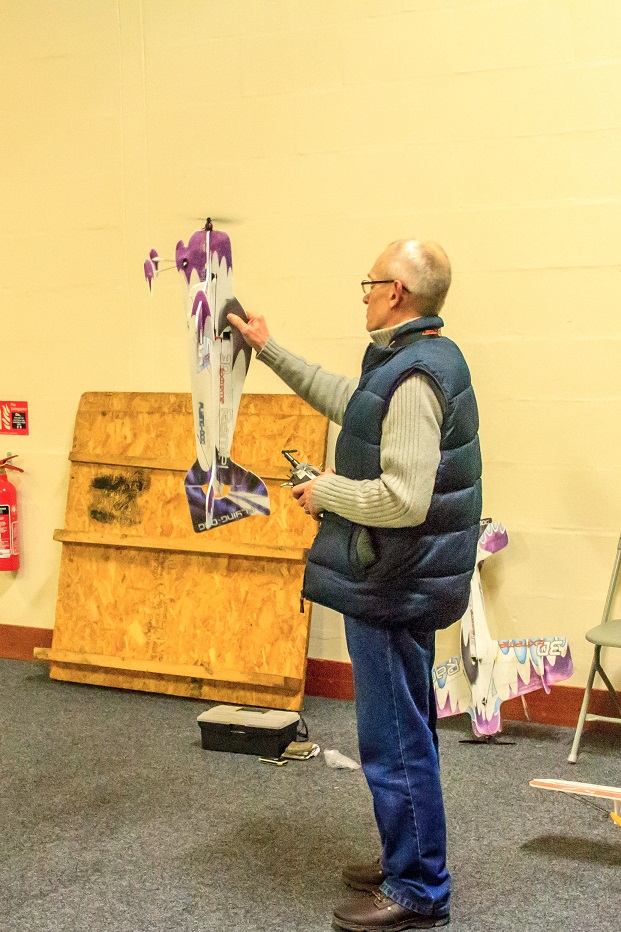|
|
||||||||||||||||
|
Christchurch and District Model Flying Club |
|
|
|
|
|
Rudder Mantra for Aerobatic knife edge/rolling manoeuvres Brian Wiseman’s last piece regarding the difficulties in applying the correct rudder for knife edge and rolling manoeuvres made me ponder how I overcame this problem years ago. I developed a simple formula for getting this right which I have set out below. It is both simple and obvious but it does overcome the need to constantly look at the model and figure out the correct rudder direction in flight. The correct rudder application needs to be automatic, if you try to work it out in flight there will invariably be mistakes and/or a crash, the human brain simply does not work quickly enough (mine certainly does not). The key is to always determine your roll direction BEFORE you start a manoeuvre, if necessary, repeat it to yourself and then simply determine if the model is upright or inverted. UPRIGHT – Rudder direction will be opposite to the roll direction. INVERTED- Rudder direction will be the same as the roll direction. For example I wish to slow roll 360 degrees to the right from UPRIGHT. I will gradually feed in left rudder as I approach knife edge, this will be gradually released as I come to inverted holding down elevator. I then continue rolling right from INVERTED, gradually releasing down elevator and now applying right rudder as I approach the second knife edge. As I continue rolling right this rudder is gradually released as I approach upright flight, possibly correcting with a tiny application of up elevator prior to releasing into level upright flight. If you decided to slow roll 360 degrees to the left the rudder will be opposite to the above i.e right rudder followed by left rudder. If I slow rolled 180 degrees right to inverted using left rudder at the knife edge and then decide to roll left back to upright, I simply look at the model which is now INVERTED, I am rolling left so the rudder will be left as well. This often catches people out but if you decide on your roll direction (left or right) first, then look at the model (upright or inverted) your rudder direction becomes automatic. This will work for slow rolls, knife edge, point rolls, rolling circles in fact all rolling manoeuvres which require rudder input to compensate for the decrease in lift as the model is on its side. Flying the manoeuvre still requires lots practice and patience whilst perfecting timing and the necessary amount of control surface deflection. All models will require different amounts of rudder depending on model design, flying weight and available power. Always remember that the throttle controls height in continuous knife edge, the correct amount of rudder will be just enough nose-up pitch attitude to maintain level flight for a given flying speed. If you are thinking this is not a problem for you as you always roll the same way then I would argue that you are simply not addressing the problem. Sooner or later the inability to roll freely in either direction will both limit your flying and cause problems further down the line. If you cannot roll freely in both directions you are committed to having different knife edge attitudes (belly in or cockpit in) depending whether you commence the manoeuvre from your left or right. We are all “handed” when it comes to roll direction preference, the solution is to roll regularly in the direction which you find the least natural until the “handed” effect disappears. It took me several years to achieve this, you may be quicker, but there is no quick fix. Equally, most people are least comfortable in the last quarter of a rolling circle, ergo this is the part to practice. Try not to simply repeat those elements you find comparatively easy to fly, be honest with yourself and concentrate on those areas where you are least comfortable. Remember to set up an aerobatic manoeuvre with plenty of height, a clear idea of what you want to achieve and a recovery plan should things go wrong. Never just slam the sticks over and hope for the best, fly the whole manoeuvre and observe where it could be improved. A second pair of eyes is often a good plan as it is easier for a non flying observer to judge the track of a model through the sky. GOOD LUCK, I hope the above helps in some small way. If you have any specific questions please feel free to drop me a line or catch me at the flying field. Simon Cole
|
|
[Home] [Chairman's Chatter] [Editorial] [Golden Jubilee] [Dynam Catalina] [Fly Diary] [Winter Wind] [The Bush page] [Rudder Mantra] [Indoor Gallery] [Astonish Aardvark] [Pilatus Porter] [Tailpiece] |
